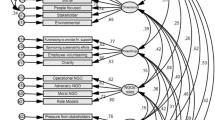Abstract
In order to implement policies towardssustainable development indicators are widelydiscussed to promote action in this direction.In addition, in many strategic documents onsustainable development (e.g., EU documents) theimportance of the development and use ofindicators is pointed out. In this contextindicators are meant to be used to supportpolitical decision making as well as toevaluate measurements towards sustainabledevelopment. In this article the developmentand use of indicators is questioned consideringtheir contextualisation and, hence, theirrelationship to existing institutions.Incorporating some of the main results from ananalysis of a regeneration programme in theLondon Borough of Southwark and from theanalysis of the Climate Protection Programme inthe city of Vienna, which are two of the casestudies examined during an EU funded projectcalled PASTILLE (Promoting Action forSustainability through Indicators at the LocalLevel in Europe), indicators are seen asdynamic sites of conflict and co-operationbetween policy actors. Different groups ofactors have diverse expectations or objectionsto this instrument. Indicators are, forexample, tools to augment transparency.Concerning certain institutional traditionsthis characteristic could explain opposition tothem.
Indicators are meant to be another opportunityfor shaping the network of relationships,forging new relationships or reinforcing oldones. They are perceived as a means by whichactors seek to exercise power, retain statusand strive towards policy goals. The stabilityand fluidity of existing structures ofgovernance will, therefore, be central factorsin determining the history and future ofindicators promoting actions towardssustainable development. To put it differently,the central question of our paper is how thenature of institutions of governance is shapingthe use and development of indicators.
Similar content being viewed by others
References
Budäus, D., Conrad, P. and Schreyögg, G. (Eds) (1998) New Public Management, Walter de Gruyter, Berlin, New York.
Briassoulis, H. (2001) Sustainable Development and Its Indicators: Through a (Planner's) Glass Darkly, Journal of Environmental Planning and Management, 44(3), 409–427.
Cartwright, L. (2000) Selecting Local Sustainable Development Indicators: Does Consensus Exist in Their Choice and Purpose? Planning Practice and Research, 15, 65–78.
Damkowski, W. and Precht, C. (1995) Public Management. Neuere Steuerungskonzepte für den öffentlichen Sektor, Kohlhammer, Stuttgart, Berlin, Köln.
Haajer, M.A. (1995) The Politics of Environmental Discourse, Oxford.
Harvey, D. (1989) From Managerialism to Entrepreneurialism: Formation of Urban Governance in Late Capitalism, Geografisker Annaler, 71B, 3–17.
Holland, L. (1997) The Role of Expert Working Parties in the Successful Design and Implementation of Sustainability Indicators, European Environment, 7, 39–45.
Jesinghaus, J. (2000) Policy Performance Indices and Their Application at the Local Level, paper presented to the International Symposium of ENSURE European Network on Sustainable Urban and Regional Development, Making Sustainable Regional Development Visible, Seggau, Austria, 13–15 Nov, pp. 16–24.
Jessop, B. (1994) Post-Fordism and the State. In: Post-Fordism, A Reader (Ed, Amin, A.), Blackwell, Oxford, pp. 251–279.
Levett, R. (1998) Sustainability Indicators — Integrating Quality of Life and Environmental Protection, Journal of the Royal Statistical Society, 161, 291–302.
Mayer, M. (1997) Urban Governance in the Post-fordist City. In: Managing Cities, The New Urban Context (Eds, Healy, P. et al.), J. Wiley & Sons, Chichester, pp. 231–250.
Minsch, J., Feind, P.-H., Meister, H.-P., Schneidewind, U. and Schulz, T. (1998) Institutionelle Reformen für eine Politik der Nachhaltigkeit, Springer, Berlin/Heidelberg.
Nurick, R. and Johnson, V. (1998) Towards Community Based Indicators for Monitoring Quality of Life and the Impact of Industry in South Durban, Environment and Urbanization, 10(1), 233–235.
Ostrom, E. (1990) Governing the Commons. The Evolution of Institutions for Collective Action, Cambridge University Press, Cambridge.
Owens, S. and Cowell, R. (2001) Going Crisply to Damnation? Challenging the Metaphor of the ‘Toolkit’, EG August/September, 12–14.
PASTILLE Consortium (2002) Indicators into Action: Local Sustainability Indicator Sets in Their Context, Final Report, London.
Pinfield, G. (1997) The Use of Indicators in Local Sustainable Development Planning: A Response to Jeb Brugman, Local Environment, 2, 185–188.
Stoker, G. (2000) Introduction. In: The New Politics of British Local Governance (Ed, Stoker G.), Macmillan Press Ltd., London, pp. 1–10.
WCED (1987) Our Common Future, University Press, Oxford.
Author information
Authors and Affiliations
Corresponding author
Rights and permissions
About this article
Cite this article
Astleithner, F., Hamedinger, A., Holman, N. et al. Institutions and indicators – The discourse about indicators in the context of sustainability. Journal of Housing and the Built Environment 19, 7–24 (2004). https://doi.org/10.1023/B:JOHO.0000017704.49593.00
Issue Date:
DOI: https://doi.org/10.1023/B:JOHO.0000017704.49593.00




